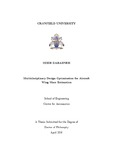JavaScript is disabled for your browser. Some features of this site may not work without it.
| dc.contributor.advisor | Kipouros, Timoleon | |
| dc.contributor.advisor | Whidborne, James F. | |
| dc.contributor.author | Dababneh, Odeh | |
| dc.date.accessioned | 2016-07-26T09:39:44Z | |
| dc.date.available | 2016-07-26T09:39:44Z | |
| dc.date.issued | 2016-04 | |
| dc.identifier.uri | http://dspace.lib.cranfield.ac.uk/handle/1826/10172 | |
| dc.description.abstract | The implementation of key technologies in the initial stages of the aircraft wing design process has always represented a substantial challenge for aircraft designers. The lack of reliable and accessible wing mass prediction methods ¬which allow assessment of the relative benefits of new technologies for reducing structural wing weight - is of significant importance. This necessitates the development of new and generally applicable wing mass estimation methods. This thesis aims to create a new framework for estimating the mass of metallic and composite transport aircraft wings via finite element multidisciplinary analysis, and design optimisation techniques. To this end, the multidisciplinary static strength and stiffness, dynamic aeroelastic stability, and manufacturing constraints are simultaneously addressed within an optimisation environment through a gradient-based search algorithm. A practical optimisation procedure is presented as part of the sizing optimisation process, with enhanced features in solving large-scale nonlinear structural optimisation problems, incorporating an effective initial design variable value generation scheme based on the concept of the fully stressed design. The applicability and accuracy of the proposed approaches is accomplished by conducting a number of case studies in which the wingbox structure of the public domain NASA wing - commonly referred to as the Common Research Model (CRM) - is optimised to produce a minimum mass design. The results of a case study examining minimisation of the mass of the CRM wingbox structures designed using four different models of increasing structural fidelity prove that the multidisciplinary design optimisation framework can successfully calculate the mass of realistic real-world aircraft wing designs. This provides an insight into the competence of certain wingbox models in predicting the mass of the metallic and composite primary wing structures to an acceptable level of accuracy, and in demonstrating the relative merits of the wingbox structural complexity models under consideration and the computational resources necessary to achieving the required degree of accuracy ... [cont.]. | en_UK |
| dc.language.iso | en | en_UK |
| dc.publisher | Cranfield University | en_UK |
| dc.rights | © Cranfield University, 2016. All rights reserved. No part of this publication may be reproduced without the written permission of the copyright holder. | en_UK |
| dc.title | Multidisciplinary design optimisation for aircraft wing mass estimation | en_UK |
| dc.type | Thesis or dissertation | en_UK |
| dc.type.qualificationlevel | Doctoral | en_UK |
| dc.type.qualificationname | PhD | en_UK |
